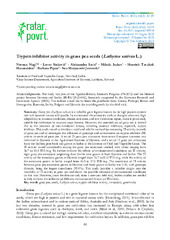Prikaz osnovnih podataka o dokumentu
Trypsin inhibitor activity in grass pea seeds (Lathyrus sativus L.)
| dc.creator | Nagl, Nevena | |
| dc.creator | Sinkovič, Lovro | |
| dc.creator | Savić, Aleksandra | |
| dc.creator | Isakov, Milada | |
| dc.creator | Hasanaklou, Hourieh Tavakoli | |
| dc.creator | Pipan, Barbara | |
| dc.creator | Marjanović-Jeromela, Ana | |
| dc.date.accessioned | 2023-10-10T07:29:28Z | |
| dc.date.available | 2023-10-10T07:29:28Z | |
| dc.date.issued | 2023 | |
| dc.identifier.issn | 1821-3944 | |
| dc.identifier.issn | 2217-8392 | |
| dc.identifier.uri | http://fiver.ifvcns.rs/handle/123456789/3788 | |
| dc.description.abstract | Grass pea (Lathyrus sativus) is a valuable grain legume known for its high protein content and rich essential amino acid profile. Its exceptional characteristics such as drought tolerance, high adaptability to extreme conditions, disease resistance, and low cultivation inputs, make it particularly suitable for cultivation by resource-poor farmers. However, the potential use of grass pea is limited due to the presence of anti-nutritional factors, including protease inhibitors, especially trypsin inhibitor. This study aimed to develop a rapid and reliable method for measuring TI activity in seeds of grass pea and to investigate the influence of genotype and environment on trypsin inhibitor (TI) activity in seeds of grass pea. A set of 25 grass pea accessions from seven European countries was cultivated in Slovenia at the Agricultural Institute of Slovenia, and a set of 12 grass pea accessions from the Serbian gene bank was grown in Serbia at the Institute of Field and Vegetable Crops. The TI activity varied considerably among the grass pea accessions studied, with values ranging from 26.7 to 90.3 TUI/mg. To further evaluate the effects of environmental conditions on TI activity, eight grass pea accessions originating from Serbia were grown in both Slovenia and Serbia. The TI activity of the accessions grown in Slovenia ranged from 26.7 to 81.0 TUI/mg, while the activity of the accessions grown in Serbia ranged from 40.3 to 57.0 TUI/mg. The correlation of TI activity between grass pea accessions grown in Slovenia and those grown in Serbia was 0.39, with genotype diversity being the largest contributor (55.9%). This study provides a valuable insight into the variability of TI activity in grass pea and shows the possible influence of environmental conditions on this trait. However, since the data are only from a one-year field trial, further studies are needed to fully evaluate the influence of different environmental factors on TI activity. | sr |
| dc.language.iso | en | sr |
| dc.publisher | Novi Sad : Institute of Field and Vegetable Crops | sr |
| dc.relation | Agrobiodiversity Research Program (P4-0072) | sr |
| dc.relation | Bilateral project Slovenia - Serbia (BI-RS/23-25-042) | sr |
| dc.rights | openAccess | sr |
| dc.rights.uri | https://creativecommons.org/licenses/by/4.0/ | |
| dc.source | Ratarstvo i povrtarstvo / Field and Vegetable Crops Research | sr |
| dc.subject | grass pea | sr |
| dc.subject | seeds | sr |
| dc.subject | Lathyrus sativus | sr |
| dc.subject | trypsin inhibitor activity | sr |
| dc.subject | accessions | sr |
| dc.subject | genebanks | sr |
| dc.title | Trypsin inhibitor activity in grass pea seeds (Lathyrus sativus L.) | sr |
| dc.type | article | sr |
| dc.rights.license | BY | sr |
| dc.citation.epage | 39 | |
| dc.citation.issue | 2 | |
| dc.citation.rank | M51~ | |
| dc.citation.spage | 32 | |
| dc.citation.volume | 60 | |
| dc.identifier.doi | 10.5937/ratpov60-45934 | |
| dc.identifier.fulltext | http://fiver.ifvcns.rs/bitstream/id/9623/bitstream_9623.pdf | |
| dc.identifier.scopus | 2-s2.0-85176246231 | |
| dc.type.version | publishedVersion | sr |


